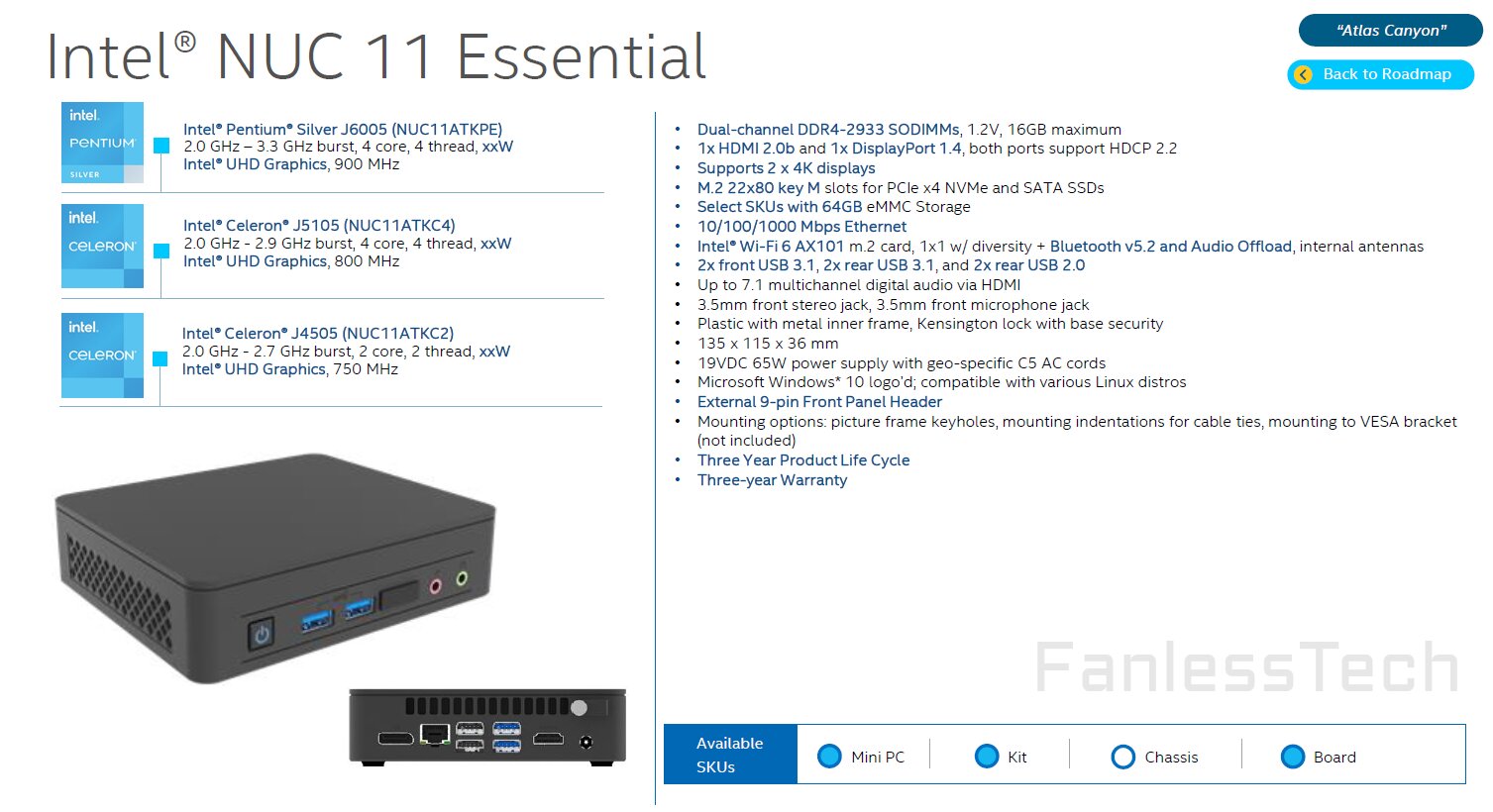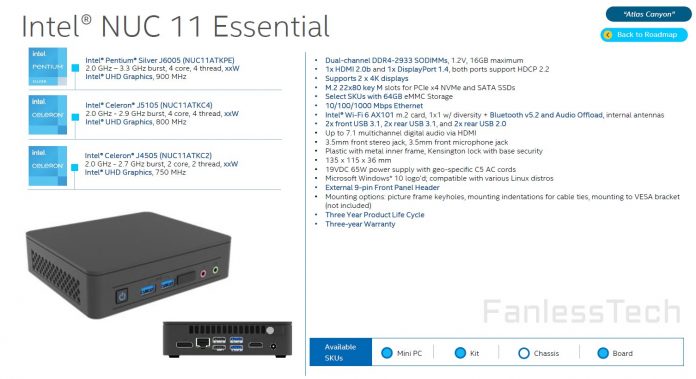Under the code name Atlas Canyon, Intel plans to launch a fourth NUC series in the 11th generation, which is the entry-level series equipped with Celeron and Pentium CPUs. Three models with different 10 nm CPUs will appear as NUC 11 Essential, which offer less maximum clock and no Xe graphics.
NUC 11 Essential in three model variants
In addition to the NUC series NUC 11 Enthusiast, NUC 11 Performance and NUC 11 Pro (test) with Tiger Lake CPUs, which have already been presented, the budget models of the mini PCs form the fourth NUC product line, Intel based on the performance NUCs of component shortages only in a few markets and in small quantities.
Two- and four-core CPUs with a low maximum clock
According to Foils from FanlessTech, these series will not follow before the first quarter of 2022 with NUC 11 Essential, a cost-effective NUC model series that comes in three variants with processors from the Jasper Lake family presented at this year's CES. According to the slide, the 10 nm CPUs specially developed for the budget sector are available in the form of the Celeron J4505, a two-core offshoot, the Celeron J5105 and the Pentium Silver J6005, each with four processing units. So far, Intel has only presented six models from Jasper Lake with the abbreviation “N” instead of “J”. There is also no trace of the “J” variants in Intel's database.
Addendum: FanlessTech has updated the article after a notice from the editors and now assumes that “very likely” actually the “N” – Versions are meant.

What they all have in common are the comparatively low maximum clock rates of 2.7 GHz, 2.9 GHz and 3.3 GHz with a TDP classification of 10 watts. The Xe-GPU, which was actually standard in the previous NUCs and was newly developed by Intel, is not present in Jasper Lake, instead the old and weak UHD GPU is used, which can clock differently to a maximum of 900 MHz depending on the performance class .
threads clock/
Turbo L2 cache L3 cache graphics EUs GPU clock LPDDR4 TDP (SDP) price mobile Pentium Silver N6000 4/4 1.1/3.3 GHz 1.5 MB 4 MB UHD 32 350/850 MHz 2.933 MHz 6 (4.8) W? Pentium Silver N5030 4/4 1.1/3.1 GHz 4 MB – HD 605 18 200/750 MHz 2,400 MHz 6 (4.8) W $ 161 Celeron N5100 4/4 1.1/2.8 GHz 1.5 MB 4 MB UHD 24 350/800 MHz 2,933 MHz 6 (4.8) W? Celeron N4120 4/4 1.1/2.6 GHz 4 MB – HD 600 12 200/700 MHz 2,400 MHz 6 (4.8) W $ 107 Celeron N4500 2/2 1.1/2 , 8 GHz 1.5 MB 4 MB UHD 16 350/750 MHz 2.933 MHz 6 (4.8) W? Celeron N4020 2/2 1.1/2.8 GHz 4 MB – HD 600 12 200/650 MHz 2,400 MHz 6 (4.8) W $ 107 Desktop Pentium Silver N6005 4/4 2.0/3.3 GHz 1.5 MB 4 MB UHD 32 450/900 MHz 2.933 MHz 10 (?) W? Pentium Silver J5040 4/4 2.0/3.2 GHz 4 MB – HD 605 18 250/800 MHz 2,400 MHz 10 (-) W $ 161 Celeron N5105 4/4 2.0/2.9 GHz 1.5 MB 4 MB UHD 24 450/800 MHz 2.933 MHz 10 (?) W? Celeron J4125 4/4 2.0/2.7 GHz 4 MB – HD 600 12 250/750 MHz 2,400 MHz 10 (-) W $ 107 Celeron N4505 2/2 2.0/2.9 GHz 1.5 MB 4 MB UHD 16 450/750 MHz 2.933 MHz 10 (?) W? Celeron J4025 2/2 2.0/2.9 GHz 4 MB – HD 600 12 250/700 MHz 2,400 MHz 10 (-) W $ 107 bold = Jasper Lake
2.5-inch installation bay was deleted
The three models NUC11ATKC2, NUC11ATKC4 and NUC11ATKPE rely on an identical housing that is flat with dimensions of 135 × 115 × 36 mm (W × D × H). As a result, there is now no space for a 2.5-inch drive, which means that the equipment variants rely either on cheap and slow eMMC storage with 64 GB or alternatively on drives in M.2 format and NVMe. RAM can take its place normally in SO-DIMM slots and is supported up to DDR4-2.933 with a maximum of 16 GB.
WLAN module mastered henceforth Wi-Fi 6
As with its predecessors with the code name June Canyon and based on Gemini Lake SoCs, the image can be output via two display outputs, once via DisplayPort 1.4 and once via HDMI 2.0b. In addition, there are six USB ports in the PC systems, four of which are still specified according to USB 3.0 with 5 Gbit/s. The connection to networks can also be made unchanged via a gigabit LAN connection or via a WLAN module that supports at least the current standard Wi-Fi 6.
Officially has Intel has not yet presented the Atlas Canyon NUCs, so the current data must be considered preliminary. It is possible that some equipment variants will be changed or that they will only be available for sale in individual markets.


